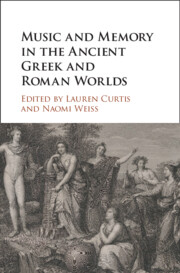Book contents
- Music and Memory in the Ancient Greek and Roman Worlds
- Music and Memory in the Ancient Greek and Roman Worlds
- Copyright page
- Contents
- Figures
- Contributors
- Acknowledgments
- Note on Texts and Abbreviations
- Part I Approaching Music and Memory
- Part II Music, Body, and Textual Archives
- Part III Technologies of Musical Memory
- Part IV Audience, Music, and Repertoire
- Part V Music and Memorialization
- Chapter 10 Sirens on the Edge of the Classical Attic Funerary Monument
- Chapter 11 Music as Mnēma on Athenian White-Ground Lekythoi
- Bibliography
- General Index
- Index Locorum
Chapter 10 - Sirens on the Edge of the Classical Attic Funerary Monument
from Part V - Music and Memorialization
Published online by Cambridge University Press: 14 October 2021
- Music and Memory in the Ancient Greek and Roman Worlds
- Music and Memory in the Ancient Greek and Roman Worlds
- Copyright page
- Contents
- Figures
- Contributors
- Acknowledgments
- Note on Texts and Abbreviations
- Part I Approaching Music and Memory
- Part II Music, Body, and Textual Archives
- Part III Technologies of Musical Memory
- Part IV Audience, Music, and Repertoire
- Part V Music and Memorialization
- Chapter 10 Sirens on the Edge of the Classical Attic Funerary Monument
- Chapter 11 Music as Mnēma on Athenian White-Ground Lekythoi
- Bibliography
- General Index
- Index Locorum
Summary
This chapter explores the confluence of music and memory in classical Athens by turning to figures of Sirens that frequently decorated sculpted funerary monuments. Perched above such monuments, as if on their roofs, Sirens are shown either playing musical instruments or in the throes of a lament, accompanied by birds, vessels, or other mourners. Although they occupy a different space than the figures of the deceased and their family carved below, Sirens often adopt similar postures and gestures, suggesting continuities between the body of the deceased and the body of the mourner on a kinesthetic level. Through an analysis of select examples of Siren monuments as well as a passage from Euripides’ Helen, I argue that these mythological creatures generate an imperative for the beholder to respond not simply through an imaginative act of empathy, but as a mourner fully invested in the tragedy at hand, one who remembers the dead. Sirens on funerary monuments suggest the synesthetic dimensions of sculpture, its ability to open up sensorial experiences that extend beyond sight and touch, and its powerful effects on our own capacity to remember.
- Type
- Chapter
- Information
- Music and Memory in the Ancient Greek and Roman Worlds , pp. 261 - 286Publisher: Cambridge University PressPrint publication year: 2021
- 1
- Cited by

